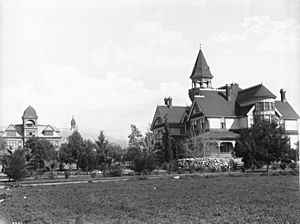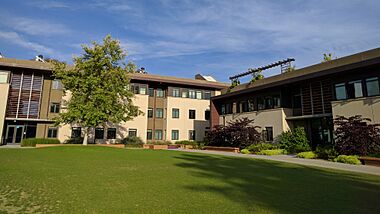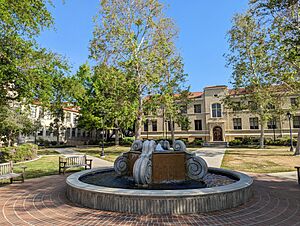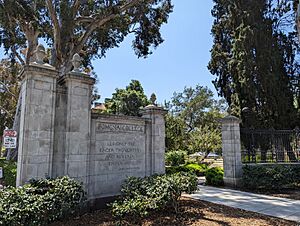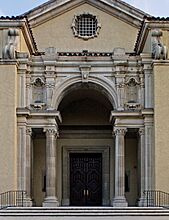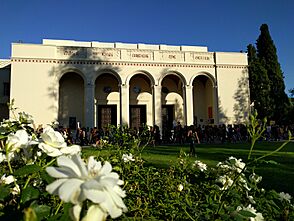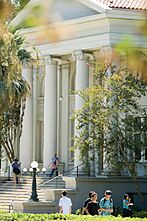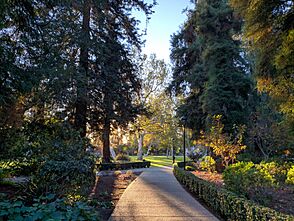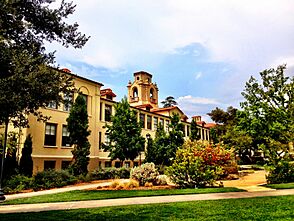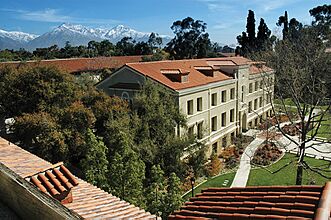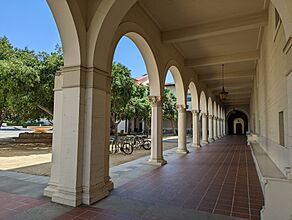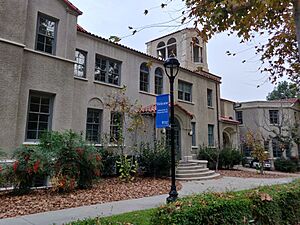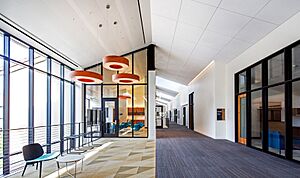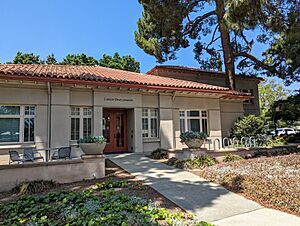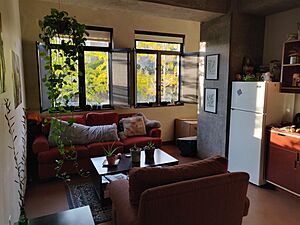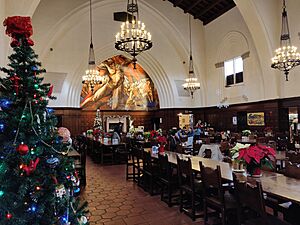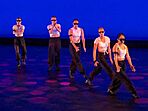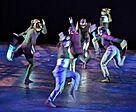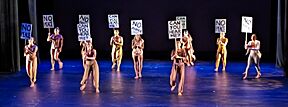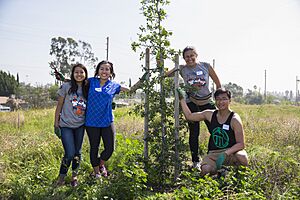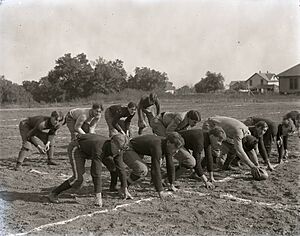Pomona College facts for kids
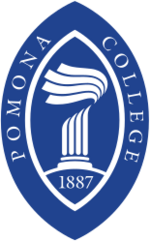 |
|
| Type | Private liberal arts college |
|---|---|
| Established | October 14, 1887 |
|
Academic affiliation
|
Claremont Colleges |
| Endowment | $3.01 billion (2024) |
| Budget | $271 million (2024) |
| President | G. Gabrielle Starr |
|
Academic staff
|
276 |
|
Total staff
|
Lua error in Module:Wd at line 1575: attempt to index field 'wikibase' (a nil value). |
| Undergraduates | 1,690 |
| Location |
,
,
United States
34°05′53″N 117°42′50″W / 34.09806°N 117.71389°W |
| Campus | Suburban, 140 Lua error in Module:Wd at line 1575: attempt to index field 'wikibase' (a nil value).[convert: unknown unit] |
| Colors | Blue and white |
| Nickname | Sagehens |
|
Sporting affiliations
|
NCAA Division III – SCIAC |
| Mascot | Cecil the Sagehen |
 |
|
Pomona College is a private college in Claremont, California. It was started in 1887 by a group of people who wanted to create a college similar to those in New England, but in Southern California. In 1925, it became the first college in the Claremont Colleges group.
Pomona is a four-year college for undergraduate students. It had about 1,690 students enrolled as of the January 2025 semester. The college offers 48 main subjects in liberal arts. Students can also take over 2,000 other courses at the other Claremont Colleges. Its 140-acre campus is in a neighborhood about 35 miles east of downtown Los Angeles. It is close to the San Gabriel Mountains.
Pomona is known as one of the best liberal arts colleges in the country. It has a large fund of over $3 billion, making it one of the wealthiest schools in the U.S. when you look at how much money they have per student. Almost all students live on campus. The college is known for having students from many different backgrounds, including different races, places, and income levels. The college's sports teams, called the Sagehens, play together with Pitzer College. They compete in Division III sports.
Many famous people have graduated from Pomona. These include winners of major awards like the Oscar and Grammy, U.S. Senators, and even a Nobel Prize winner. The college also helps many students get special scholarships for further studies.
Contents
History of Pomona College
How Pomona College Started
Pomona College opened its doors on October 14, 1887. It was open to both boys and girls and was a Christian school. The founders wanted to build a college like those in New England. Classes first started in a rented house in Pomona, California, in September 1888. The college then moved to Claremont, California, to an unfinished hotel building, which was later named Sumner Hall. It kept the name Pomona College. The first group of students graduated in 1894, with 11 members.

In its early years, Pomona College faced money problems. But it raised enough funds to add more buildings. The first Asian and Black students joined in 1897 and 1900. In 1905, the college bought 64 acres of land called the Wash. In 1911, the college stopped offering high school-level courses. It decided to focus only on a liberal arts education. In 1914, the Phi Beta Kappa honor society started a chapter at the college.
Pomona College in the Mid-1900s

In the 1920s, more students wanted to attend Pomona. The college's president, James A. Blaisdell, had an idea. He wanted to create a group of independent colleges that could share resources. This idea was inspired by colleges like Oxford University. On October 14, 1925, Pomona College started the Claremont Colleges group.
During the Great Depression, fewer students could afford tuition. The college's budget was cut. During World War II, Pomona helped with the war effort. It hosted programs for military meteorology and engineering.
Changes After World War II
From 1941 to 1969, E. Wilson Lyon was the president. The number of students grew to over 1,000 after the war. This led to new dorms and science buildings. The college's money also grew.
President Lyon made important decisions about civil rights. He supported Japanese-American students during their internment. He also started an exchange program with Fisk University, a historically Black university. He and the dean of women ended the separation of boys and girls in dorms. They opened Frary Dining Hall to women in 1957. Co-ed housing started in 1968. Students became more interested in politics during this time. The college also became more diverse, with more students from different ethnic backgrounds.
During David Alexander's time as president (1969-1991), Pomona became more well-known. The college's funds grew a lot, which helped build and fix many buildings. More students from outside California started coming to Pomona in the mid-1980s. In 1991, the college changed fraternity basements into common lounges. This made Greek life less central to campus social life.
Pomona College in the 2000s
In the 2000s, under President David W. Oxtoby, Pomona focused on being more environmentally friendly. It aimed for new buildings to be LEED certified. The college also partnered with groups to help more students from different backgrounds attend. It started to cover the full financial need of students with grants, not loans. This helped more low-income and minority students enroll.
In 2008, it was found that Pomona's college song might have been part of a minstrel show in 1910. The college stopped singing it at official events. In 2017, G. Gabrielle Starr became Pomona's tenth president. She is the first woman and first African American to hold this position. From March 2020 to spring 2021, the college taught classes online because of the COVID-19 pandemic.
Pomona College Campus
Pomona's 140-acre campus is in Claremont, California. This is a nice neighborhood about 35 miles east of downtown Los Angeles. The campus is next to the Claremont Village, which is the city's main shopping area. It is also south of the other Claremont Colleges. The area has a warm, dry climate.
In its early years, Pomona grew quickly from its first building, Sumner Hall. The campus was designed with a central open area called a quadrangle. Buildings were connected by clear views and paths. Many early buildings were built in the Spanish style, with stucco walls and red tile roofs. Later buildings mixed in other styles, like modern and Victorian. This means the campus now has a mix of different building looks. Most buildings are not very tall, and they are designed for both indoor and outdoor use.
As of 2023, the campus has 88 facilities, including 70 buildings. It is divided into North Campus and South Campus by Sixth Street. Most academic buildings are on the western side. A natural area called the Wash is on the eastern side. Pomona's campus has been used in many movies and TV shows.
Pomona works to make its campus more sustainable. All new buildings must meet high environmental standards. They also replace grass with plants that need less water. The college aims to be carbon neutral by 2030.
South Campus Buildings
South Campus has dorms for first-year and second-year students. It also has academic buildings for social sciences, arts, and humanities.
A group of four dorms is south of Bonita Avenue. Frank Dining Hall is at the end of this row. Sumner Hall, which houses admissions, is north of the dorms. Oldenborg Center, a dorm for students studying foreign languages, is across from Sumner.
South Campus has several arts buildings. Bridges Auditorium is used for concerts and speakers. It can hold 2,500 people. Bridges Hall of Music is a smaller concert hall. The Benton Museum of Art has a collection of about 18,783 art pieces. These include Italian paintings and art from Native Americans. The Seaver Theatre Complex has two theaters. The Studio Art Hall, finished in 2014, is known for its cool steel design.
Pomona's main social science and humanities buildings are west of College Avenue. This includes the Carnegie Building, a beautiful building from 1908. Many old Victorian houses are along the southern part of the avenue.
Marston Quadrangle is a 5-acre lawn with trees. It is a main pathway for the campus. Alexander Hall, the college's main office building, is north of the quad. The Smith Campus Center (SCC) has many student services. East of the SCC is the Center for Athletics, Recreation and Wellness.
At Sixth Street and College Avenue are the college gates, built in 1914. They have two quotes from Pomona's fourth president, James A. Blaisdell. One says, "let only the eager, thoughtful and reverent enter here." The other says, "They only are loyal to this college who departing bear their added riches in trust for mankind." New students walk south through the gates when they arrive. Graduating students walk north through them before they leave.
The eastern part of campus is called the Wash. It has many coast live oak trees and sports facilities. It also has an outdoor theater, an observatory, and the Pomona College Organic Farm. This farm is an experiment in sustainable agriculture.
North Campus Buildings
North Campus was designed by architect Sumner Spaulding. It has dorms for third- and fourth-year students. It also has academic buildings for science subjects.
The academic buildings are west of North College Way. This area includes Dividing the Light (2007), a special art installation by artist James Turrell.
The dorms include the Clark halls. Frary Dining Hall is the main dining hall on North Campus. It has a high ceiling and famous murals. These include Prometheus (1930) by José Clemente Orozco and Genesis (1960) by Rico Lebrun.
-
Arcade along Bixby Plaza
(view as a 360° interactive panorama)
Other College Facilities
Pomona College owns other properties. These include the 53-acre Trails Ends Ranch, a wilderness area. It also has the 320-acre Mildred Pitt Ranch and the Halona Lodge retreat center. The astronomy department has a telescope at the Table Mountain Observatory.
Along the north side of campus are buildings shared by The Claremont Colleges Services. The Claremont Colleges also own the Robert J. Bernard Field Station.
How Pomona College is Run
College Leadership

Pomona College is run by a board of trustees. This board makes sure the college is managed well for the long term. The board hires the college's president, who is currently G. Gabrielle Starr since July 2017. The president manages the daily operations of the college. Pomona has about 902 employees. Students and professors also help make important decisions for the college.
Working with Other Colleges
Pomona is the first college in the Claremont Colleges group. This group includes five undergraduate colleges and two graduate schools. All of them are in Claremont. Each college is independent, but they work together a lot. They share resources like the main library, campus safety services, and health services. Pomona is the largest and wealthiest college in this group.
Pomona is also part of other groups of colleges. The college is officially approved by the WASC Senior College and University Commission.
Money and Student Costs
Pomona has a large fund of over $3 billion as of June 2024. This means it has one of the highest amounts of money per student in the U.S. The college's total value, including its campus, is over $3.9 billion. Its budget for the 2024-2025 school year was over $271 million. About half of this money comes from its fund.
For the 2024-2025 school year, tuition was $65,000. The total cost to attend and live on campus was about $89,414. In 2024-2025, 55% of students received financial help. The average amount of help was $67,027. Pomona helps all admitted students who need financial aid. They give grants, which do not need to be paid back, instead of loans. The college does not offer scholarships for good grades or sports.
Academics and Programs
Pomona offers a liberal arts education. Students earn a Bachelor of Arts degree. The college uses a semester system. Students usually take four classes each semester. To graduate, students need 32 credits and a C average. They also need to complete requirements for their major. They must take a first-year seminar, courses in six different study areas, and show they can speak a foreign language.
Pomona offers 48 main subjects, called majors. Most majors also have a smaller option called a minor. For the 2023 graduating class, students studied arts, humanities, natural sciences, social sciences, and interdisciplinary fields. Many students chose to study two majors or a major and a minor. The college does not offer majors in fields like medicine or law. However, it gives advice for students interested in these careers.
Classes and Learning
Individually, Pomona offers about 650 courses each semester. Students can also take classes at the other Claremont Colleges. This means they have access to about 2,700 courses in total. It is easy to sign up for classes across the colleges, and there are no extra fees.
All classes at Pomona are taught by professors, not teaching assistants. The average class size is 15 students. In fall 2024, most classes had fewer than 30 students. The college has 276 professors. This means there are about 7 students for every professor. Professors and students often form close relationships. The college encourages professors to eat meals with students.
Research and Study Abroad
More than half of Pomona students do research with professors. The college has a Summer Undergraduate Research Program (SURP). Over 200 students get paid to do research with professors or on their own.
About half of Pomona students study abroad. As of 2024, the college offers 68 approved programs in 37 countries. Students can also study away in places like Washington, D.C., or Silicon Valley.
The Career Development Office (CDO) helps students and alumni with career advice. It runs the Pomona College Internship Program (PCIP). This program gives money to students who do unpaid or low-paid internships. Over 250 students take part each year. The office also connects students with alumni for advice.
Student Success After College
Most Pomona students return for their second year. This is one of the highest rates in the U.S. For the class that started in 2018, 61% graduated within four years.
Within 10 years, 81% of Pomona graduates go to graduate or professional school. Pomona is ranked high for the number of alumni who earn doctorates. Many graduates go to top universities like UCLA, UC Berkeley, and Harvard.
Graduates work in many fields, including technology, education, and finance. Pomona alumni earn good salaries after college. The college is also a top producer of students who win important scholarships for further study.
College Reputation and Rankings
| USNWR Liberal Arts College | 5 |
|---|---|
| Washington Monthly Liberal Arts | 10 |
| Forbes | 37 |
Pomona is known as one of the most respected colleges in the country. The 2025 U.S. News & World Report rankings placed Pomona tied for fifth among national liberal arts colleges. In 2015, Forbes magazine ranked Pomona first among all colleges and universities in the U.S.
People at Pomona College
How to Get Admitted
| Admissions statistics | |
|---|---|
|
2024 entering
classChange vs. 2019 |
|
| Admit rate | 7.0%
(
|
| Yield rate | 50%
(
|
| Test scores middle 50%* | |
| SAT EBRW | 740–770
(
|
| SAT Math | 750–790
(
|
| ACT Composite | 33–35
(
|
| High school GPA† | |
| Top 10% | 90%
(
|
| Top 25% | 99%
(
|
| Top 50% | 100%
(
|
|
|
Students can apply to Pomona using the Common Application, QuestBridge, or Coalition Application. Some students apply early for a binding decision. The college also accepts students through the Posse Foundation program.
Pomona looks at many things when deciding who to admit. They care most about how challenging a student's classes were, their class rank, grades, essays, and recommendations. They also look at extracurricular activities and character. Test scores, being a first-generation college student, and where a student lives are also considered. Pomona does not consider family connections or religious beliefs. The college aims to help students from all backgrounds attend.
For the class that started in 2024, Pomona accepted 7.0% of applicants. Of those accepted, 50% chose to enroll. In 2024, Pomona accepted 44 out of 509 transfer students.
Student Body at Pomona
White (28.9%) Asian (18.4%) Hispanic (16.7%) Black (9.1%) Pacific Islander (0.5%) Native American (0.1%) Multiracial (9.4%) International (13.6%) Unknown (3.3%)
As of the January 2025 semester, Pomona had 1,690 undergraduate students. The student body is about half men and half women. Most students are under 22 years old. About 65% of U.S. students are non-white, and 14% are international students. This makes Pomona one of the most diverse colleges in the U.S. Students come from all 50 U.S. states and over 60 foreign countries.
For students in the 2024 entering class who submitted test scores, the middle 50% scored high on the SAT and ACT tests. Most students with a high school class rank were in the top 10% of their class.
Famous Alumni and Faculty
| Name | Class | Notability | |
|---|---|---|---|
| David P. Barrows | 1894 | Anthropologist, educator | |
| Chen Hansheng | 1920 | Chinese social scientist | |
| Joel McCrea | 1928 | Westerns film actor | |
| John Cage | 1932‡ | Avant-garde composer | |
| Robert Taylor | 1933 | Film actor | |
| Alan Cranston | 1936‡ | U.S. senator (D‑CA) | |
| James H. Howard | 1937 | World War II ace pilot | |
| Robert Shaw | 1938 | Choir conductor | |
| Art Clokey | 1943‡ | Stop motion animator | |
| Roy E. Disney | 1951 | Disney executive | |
| Richard Chamberlain | 1956 | Film actor, singer | |
| Robert Towne | 1956 | New Hollywood screenwriter | |
| Kris Kristofferson | 1958 | Outlaw country singer | |
| James Turrell | 1965 | Light and Space artist | |
| Myrlie Evers‑Williams | 1968 | Civil rights activist | |
| Bill Keller | 1970 | The New York Times editor | |
| Marianne Williamson | 1974‡ | Self-help author, activist | |
| Jennifer Doudna | 1985 | Biochemist, Nobel laureate | |
| Brian Schatz | 1994 | U.S. senator (D‑HI) | |
| ‡ Did not graduate from Pomona | |||
| Name | Active tenure | Notability | |
|---|---|---|---|
| Leonard Pronko | 1957–2014 | Kabuki scholar | |
| Michael Armacost | 1960s | U.S. ambassador | |
| Stanley Crouch | c. 1969 – c. 1975 | Cultural critic | |
| Bobby Bradford | 1974–2021 | Jazz musician | |
| Frank Gibney | c. 1979 – c. 2006 | Journalist | |
| Gregg Popovich | 1979–1988 | Basketball coach | |
| Samuel H. Yamashita | 1983–present | Historian | |
| David Foster Wallace | 2002–2008 | Essayist, novelist | |
| Claudia Rankine | 2006–2015 | Poet | |
| Jonathan Lethem | 2011–present | Novelist | |
| Cameron Munter | 2013–2015 | U.S. ambassador |
Student Life at Pomona
Living on Campus
Almost all Pomona students live on campus for all four years. They live in one of the college's sixteen dorms. First-year students live on South Campus. Most older students live on North Campus. Housing options include single rooms, double rooms, and "friendship suites" with several rooms around a common area.
All new students are placed into a "sponsor group." This group has 10 to 20 other students and two or three older student "sponsors." The sponsors help new students get used to college life. Sponsor groups often do fun activities together, like "fountaining." This is a tradition where students are playfully thrown into a campus fountain on their birthday.
Pomona's social life is connected to the other Claremont Colleges. Many activities and events are shared among the colleges.
Pomona's dining services are run by the college. All students living on campus must have a meal plan. This plan can be used at any of the seven dining halls across the Claremont Colleges. The food focuses on healthy and sustainable options. Students generally like the food quality. Frary Dining Hall offers a late-night snack Sunday through Wednesday. Meal plans also include "Flex Dollars" for campus eateries like the Coop Fountain.
Student Groups and Activities
Some student groups at Pomona are just for Pomona students. Others are open to students from all the Claremont Colleges. There are almost 300 clubs and organizations across the five colleges.
The Associated Students of Pomona College (ASPC) is Pomona's student government. They give money to clubs, represent students, and plan events. One popular event is "Ski-Beach Day."
Pomona has many clubs and support offices for students with different backgrounds. These include groups for female students, students of color, international students, and LGBTQ+ students. The FLI Scholars group supports first-generation and low-income students.
The Pomona Student Union (PSU) helps students discuss important topics. They host talks and debates with different speakers. Pomona's secret society, Mufti, is known for leaving small papers with clever puns around campus.
Pomona's music department has many groups. These include an orchestra, band, choir, and jazz ensemble. All students can get free private music lessons.
The Draper Center for Community Partnerships helps students get involved in the community. They offer mentoring for local youth and English tutoring for college staff. They also organize volunteer trips during spring break. The Pomona Academy for Youth Success (PAYS) is a summer program for local low-income students.
Pomona has two co-educational Greek organizations, Sigma Tau and Kappa Delta. They do not have special housing. Greek life is not a big part of the social scene at Pomona.
College Traditions
The Number 47
The number 47 is a special inside joke at Pomona College. It started in 1964 when a student did a research project. He found that the number 47 appeared often in nature. Since then, students and staff have found the number 47 everywhere on campus. It is in buildings, signs, and even the clock tower chimes at 47 minutes past the hour. It is a fun tradition that connects the college community.
Other Fun Traditions
Pomona's orientation for new students includes a 4-day "Orientation Adventure" (OA) trip. This program started in 1995 and is one of the oldest outdoor orientation programs in the U.S.
Every spring, the college has "Ski-Beach Day." Students go to a ski resort in the morning and then to the beach after lunch. This tradition started in 1891.
Since the 1970s, Pomona has used a wall called Walker Wall for free speech. Students can post messages on it.
Getting Around Campus
Pomona's campus is next to Claremont station. From here, the Metrolink train goes to Los Angeles Union Station. Buses also connect to nearby cities.
Pomona has a "Green Bikes" program. Students can rent one of over 300 bicycles for free each semester. Older students can park their cars on campus. The college also has Zipcar vehicles for rent. There are also college-owned vehicles for club trips.
Sports and Athletics
Pomona-Pitzer Sagehens
Pomona's sports teams play together with Pitzer College. They are called the Pomona-Pitzer Sagehens. There are 11 women's teams and 10 men's teams. They compete in NCAA Division III sports. The mascot is Cecil the Sagehen, which is a type of bird. The team colors are blue and orange. Their main rival is the Claremont-Mudd-Scripps teams.
Students can also join club sports or intramural sports. These include dodgeball, flag football, and surfing. The physical education department offers many activity classes.
History of Pomona Sports
Pomona's first sports teams started in 1895. The name "Sagehen" first appeared in 1913 and became the official name in 1917. Pomona was one of the first three colleges to form the SCIAC sports conference in 1914. In 1970, Pomona's sports program joined with Pitzer College.
See also
 In Spanish: Pomona College para niños
In Spanish: Pomona College para niños


